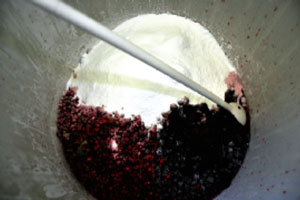
Wine clarifiers, or “fining agents” as they (and a whole host of other wine-finishing additives) are called, are creatures of degrees. What I mean is that they enact some sort of chemical or physical activity on one’s wine, usually binding to and settling out of solution some unwanted compound (excess tannin, cloudy protein, etc.) in the finished wine, usually on a sliding scale. Add too little and, in your case, you may not see the clarity that you would want. Add too much, and you’ll get clarity in spades, but perhaps strip out aroma, color or mouthfeel that you would’ve rather kept.
This is why, no matter what the additive or step, I always advocate “bench trials” first in winemaking. Bench trials are small-scale trials, little lab experiments if you will, where one measures out a little bit of wine and a little bit of the additive, carefully weighed or pipetted, and tries out a range of additive for effect. Once the desired result has been tested and tasted the treatment is then multiplied up to correspond to the total batch volume. Though it may seem a little tedious, well-measured bench trials, backed up by careful note taking and record keeping, are what build up the experience and skill set of the winemaker as well as, more immediately and obviously, prevents batch-ruining disasters.
Sometimes we don’t have the equipment, time or patience to do bench trials, however. Especially when measuring tiny amounts of an additive, one often needs specialist equipment like a gram scale that will go to tenths or hundredths of a gram, and micro-pipettes for measuring liquid additives. Expensive equipment, I know, but a purchase that can often be shared between members of a winemaking club or group of friends. However, what you’re doing, making up wines in very small batches (1–2 gallons/3.8–8.5 L instead of a full 15-gallon (57-L) keg or full barrel) and then seeing how they come out with different treatments is another wise way to proceed. Be sure to take notes as you go along so you get a sense of what works and what doesn’t, what pleases you and what you can live without. Your “bench trial” for your clarifying agent could be to test the clarifying power of half of a packet (presumably a 2.5-gallon (9.5-L) dose, if it reads that it is sized for 5) or even a quarter of a packet. You may be surprised by what works the best for you because often the manufacturer’s recommended dose is simply an arbitrary range based on their experience. Because each batch of wine is different and each situation unique, you may find you need a lot of one fining agent, or very little of another. Experimenting with bench trials are best when trying anything new in your winery, but when you can’t or don’t want to do them, a conservative step-wise approach to adding anything to our wines, be it tartaric acid, bentonite or even barrel time, is often just as good.


